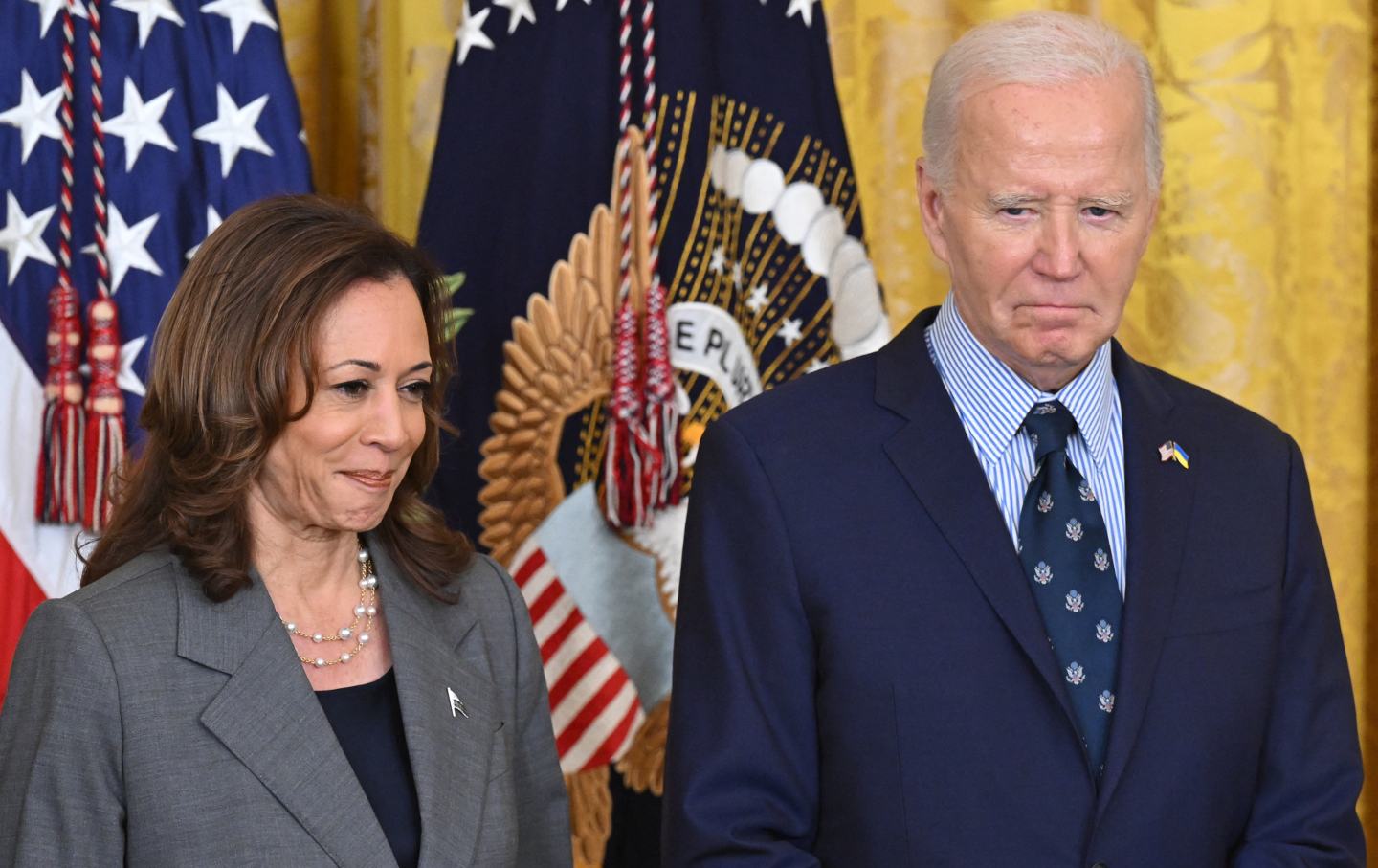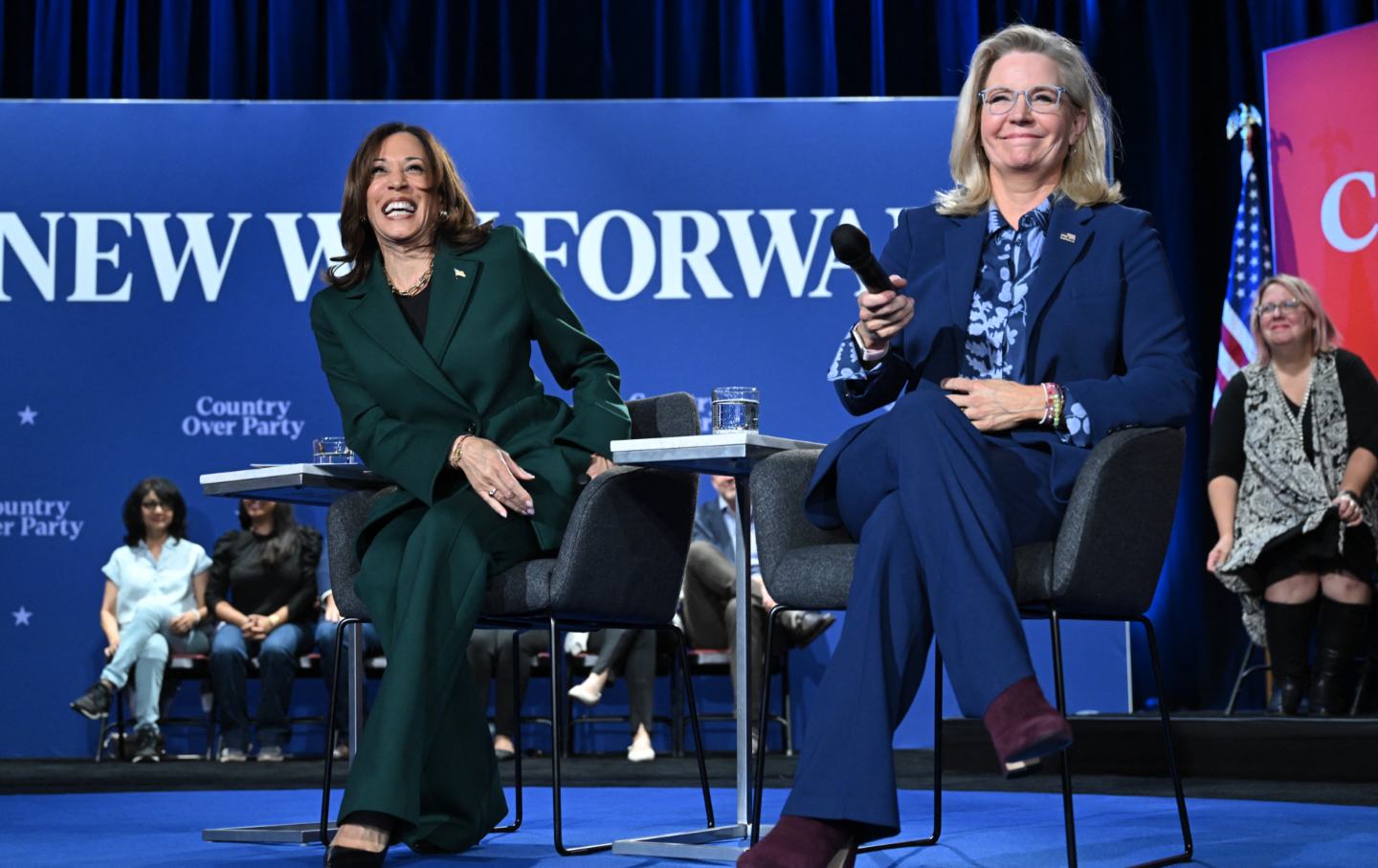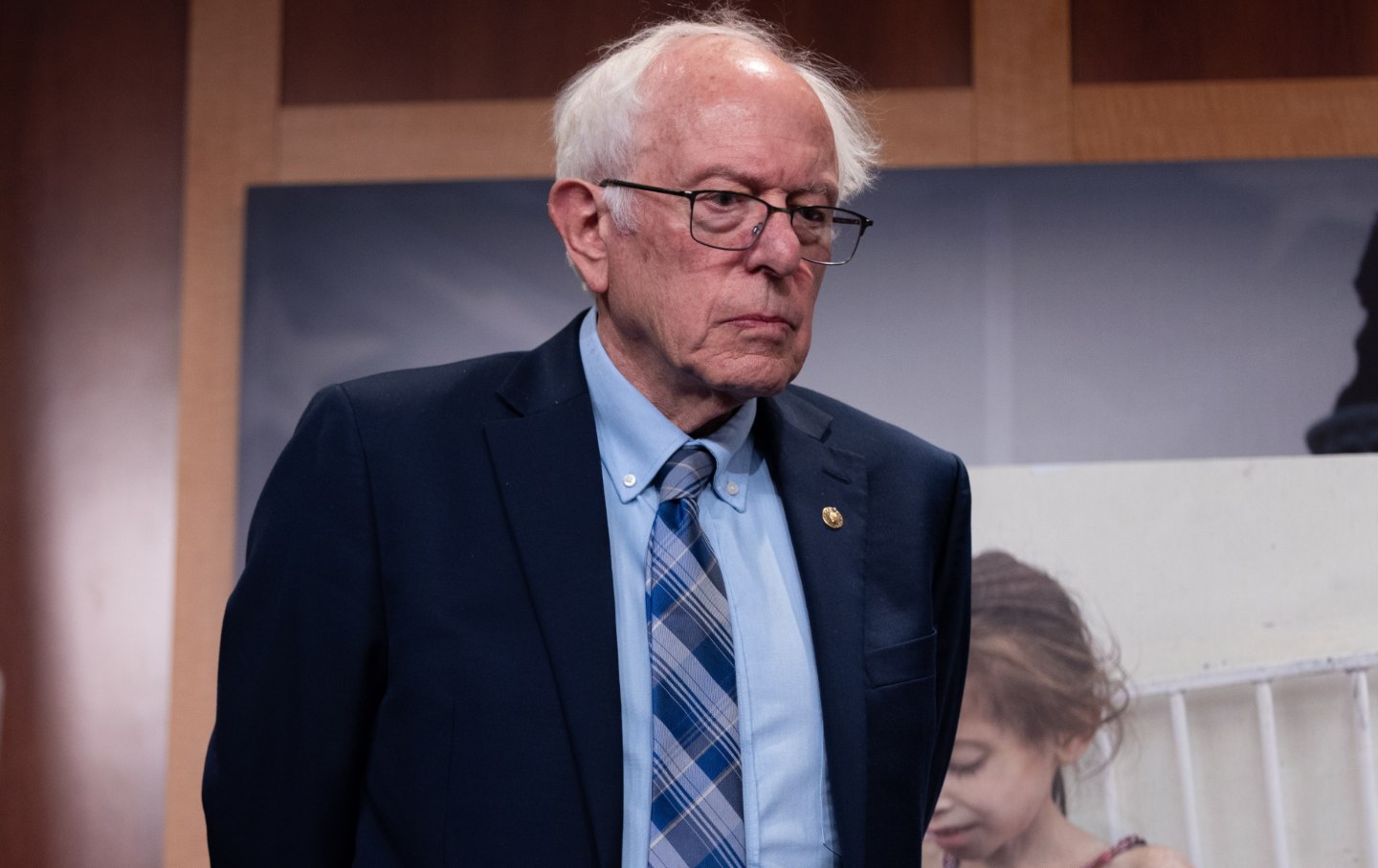Democrats Need to Fundamentally Rethink Everything
The lesson from 2024 is clear: If voters don’t see you as an agent of transformational change, they will turn to someone like Donald Trump.

President Joe Biden and Vice President Kamala Harris attend an event on gun violence in the East Room of the White House in Washington, DC, on September 26, 2024.
(Saul Loeb / AFP via Getty Images)As the dust settles from the 2024 election, and we all prepare ourselves for the far-right onslaught of a second Donald Trump administration, one thing is clear: Democrats need to fundamentally rethink their approach to both politics and policy, and they need to do it now.
Kamala Harris faced a near-impossible task in 2024. Inflation and the cost of living were soaring, and the Biden-Harris administration had been struggling for years to show Americans how it had improved their lives. Working-class voters, in particular, wanted concrete changes they could see and feel, not just promises and statistics.
Trump, with his brash populism and conspiracy-laden rhetoric, was more than ready to fill that void. He framed economic hardships as proof of Democratic incompetence, tapping into the frustrations of working-class communities who increasingly felt alienated from a Democratic Party that seemed more concerned with elite agendas than with their daily challenges.
So yes, the hurdles for Harris were high. But this dynamic was not new. As far back as October 2020, Representative Alexandria Ocasio-Cortez warned the leaders of her own party that “if these people’s lives don’t actually feel different, we’re done. You know how many Trumps there are in waiting?” For many voters, the Democratic establishment’s cautious, incremental approach feels disconnected from the pressing economic and cultural pressures reshaping their lives. Ocasio-Cortez’s message was true then, and it is still true now: Without bold, transformative action, Democrats risk ceding these voters to populists who promise to dismantle a system that feels rigged and unresponsive—as they found out so calamitously on Tuesday.
Yet, even as millions of Americans made more and more noise about the depth of their discontent with the status quo, a significant portion of Democratic leaders and voters remained focused on preserving institutional stability rather than reimagining these institutions to reflect the values they were built to serve. In an era of growing inequality and instability, many Americans no longer take the necessity of maintaining “normal” governance as a given. They’re open to upending the system if they think that will make politics more responsive to their needs.
Now that voters have so emphatically shown that abstract warnings about Trump’s danger to “democracy” are not enough to make them reject his rule, Democrats need to urgently change course. They must move beyond merely defending institutions and start showing how they will actually make them work for the people they’re meant to protect. If the party fails to embrace real reform, it risks leaving the door open for another Trump-like figure to exploit dissatisfaction and promise radical change—no matter how reckless—long after Trump has left the political stage.
The party’s cloistered internal governance is also in drastic need of an overhaul. Joe Biden’s decision to remain at the helm instead of opening up a primary and passing the torch to a new generation is probably the defining piece of this election. In 2020, he positioned himself as a transitional figure, suggesting he would create space for fresh leadership. But by choosing to stay, he anchored Democrats to a status quo that many voters associate with malaise and stagnation, rather than change. And by failing to be honest with itself or the public about the need for Biden to drop out, the party let this malaise fester until it was too late.
Twenty twenty-four became, in many ways, a referendum on Biden himself, giving Republicans an opening to cast themselves as the party of change. And for many voters, the transition from Biden to Harris only heightened a sense that the Democratic Party operates as a closed loop, more attuned to the concerns of elite insiders than those of ordinary Americans. By tying their message to working-class frustration and disillusionment with an administration seen as disconnected from everyday struggles, Republicans managed to position themselves as the disruptors of an unresponsive system. The irony is palpable: The GOP, a party traditionally aligned with preserving the existing order, has successfully branded itself as the agent of upheaval.
Harris inherited the deep skepticism voters had toward Biden. Her adaptability, seen by supporters as an effective sign of political flexibility, was read instead as a lack of conviction—a signal that she was more of a steward of the establishment than a leader with a clear, independent vision. By establishing zero difference between her and Biden—even declaring that she couldn’t think of anything she would have done differently from him—Harris inadvertently confirmed doubts about her independence, leaving many voters wondering if she were truly her own person or just another avatar for the status quo. In contrast, Trump, for all his flaws, managed to project a consistent authenticity and a defiant stance that, to many, felt like real conviction.
Another hurdle Harris faced was the sheer breadth of the anti-Trump coalition she was trying to hold together. Forging solidarity across such a wide political spectrum isn’t just a challenge—it’s an acrobatic feat. This coalition stretches from The Squad to Liz Cheney, weaving together a patchwork of beliefs, priorities, and visions for America that sometimes barely overlap. To keep everyone on the same page, Democrats must find a way to bridge divides across race, class, ideology, and urgency, bringing together working-class Black, Latino, and Asian communities, suburban moderates, and anti-war and progressive youth.
But sometimes this balancing act makes the Democratic Party feel more like a patchwork of interest groups than a unified force with a clear direction. With factions pulling in so many directions, creating a shared vision can feel impossible. It deepens the impression that Democrats care more about managing competing demands than building a collective will. Meanwhile, the GOP’s streamlined message creates a sense of unity that resonates as strength and stability. While Democrats aim to hold the line between progress and pragmatism, they risk leaving some voters wondering if the party stands for anything cohesive at all. The GOP has a much simpler task. Its message—strength, tradition, a return to order—unites conservatives across the board, drawing from a playbook as old as power itself.
A key factor in Harris’s loss seems to be the significant drop-off in support from Biden’s 2020 voters, who simply didn’t show up for her. While Trump’s vote count remained largely stable compared to 2020, Harris’s numbers reveal a substantial dip—about 14 million fewer votes than Biden received in 2020. This decline suggests that Harris’s challenge wasn’t necessarily to convert the elusive Liz Cheney voters she spent so much time chasing but rather to energize the Democratic base that turned out in record numbers four years ago.
The 2024 election also shows a dramatic class realignment in American politics. According to exit polls, Harris won affluent voters earning over $100,000 by a margin of 54–45, reversing Trump’s 54–42 advantage with this group in 2020. But this swing in her favor wasn’t enough to offset Trump’s gains with voters earning $50–$100,000, where he captured the majority—a group Biden had comfortably held at 57–42 just four years prior.
Trump also made crucial gains with men, pitching a stark, patriarchal version of masculinity that resonated powerfully with disillusioned male voters. His campaign leaned heavily into themes from the “Manosphere,” an online space filled with content that glorifies traditional male authority and strength while positioning these qualities as threatened by modern social norms. Figures like Joe Rogan and Vice President–elect JD Vance amplified this narrative, offering a platform that embraced rugged self-reliance and unapologetic male confidence.
Popular
“swipe left below to view more authors”Swipe →This approach filled a cultural void, particularly for younger men who may have felt sidelined by a liberal discourse focused on critiquing “toxic masculinity” rather than perhaps offering an alternative vision of masculinity. While Trump’s stance gave these voters a sense of purpose and belonging, Harris’s campaign largely struggled to connect with men, especially young ones. Her attempts to reach male voters through initiatives like “Dudes for Harris” fell short against Trump’s more visceral appeals.
Moreover, Harris’s stance on Israel and Gaza—especially her refusal to break with any aspect of Biden’s policies— was toxic to many young, progressive voters, as well as Arab and Muslim voters. Cities like Hamtramck and Dearborn, once Democratic strongholds, became symbols of a realignment, as longtime Arab and Muslim Democrats not only grew disappointed but actively mobilized against her. Meanwhile, youth are vital messengers for any movement, carrying its energy across generations; their disillusionment with Harris, particularly over Gaza, broke a crucial link in that chain of support.
And Trump’s appeal accelerated a political shift in the Latino community. His rhetoric on race and immigration resonated with segments of Latino voters, particularly men, who viewed themselves as outside traditional racial categories, challenging Democratic assumptions about minority solidarity.
According to recent data, only 25 percent of Latinos identify as “people of color” similar to African Americans, skeptical of conservative messaging and aligned with progressive ideals. But larger pluralities of Latinos see themselves either as “white ethnics” or “bootstrappers” moving into mainstream American identity over generations, or as individuals who can “get ahead through hard work,” without being held back by systemic racism. Trump tapped into this mindset, using language that appealed to those who—like Irish and Italian immigrants of the past—aspired to integrate into America’s dominant social fabric, complicating standard narratives about Latino voting behavior and dramatically reshaping the coalition landscape.
On top of all of these headwinds, Harris’s difficulties were compounded by the media landscape. While Trump skillfully sidestepped conventional scrutiny, dominating social media with provocative statements, Democrats found themselves constrained by mainstream news cycles and fact-checked speeches. In a media environment where attention is currency, Trump’s sensationalism gave him an edge. The Republican media ecosystem, meanwhile, thrived, reinforcing Trump’s narrative and overshadowing Democratic policies. Many on the right view media not just as news but as a worldview, while Democrats struggled to compete in the outrage economy Republicans have mastered.
In the end, Harris’s campaign found itself caught between perception and reality. Trump’s outsider narrative, coupled with his adept use of media, allowed him to position himself as a champion of the common person—a role Harris ultimately could not match.
So what is to be done? For the moment, Democrats are deep in the political wilderness—with the White House lost, a conservative supermajority on the Supreme Court, and GOP control of both chambers of Congress looking like a distinct possibility.
Small tweaks won’t cut it. Trying the same methods that have failed so badly won’t cut it. If Democrats hope to first regain and then retain power, they need a clear, compelling identity that resonates beyond elite circles and connects deeply with Americans who feel left behind. Without this shift, they risk a long-term fracturing of the coalition that once brought them to power, leaving the door open for another wave of populist backlash.
The US political system, with a thousand veto points, makes sweeping policy change nearly impossible without overwhelming party majorities—especially in the Senate, where even reforming the filibuster requires more than a simple 50-vote majority. This structure limits Democrats’ ability to deliver the large-scale social programs that would tangibly improve working-class lives and reinforce faith in democratic governance. This isn’t an accident. The Senate, the Electoral College, the Supreme Court—these structures don’t allow majorities to rule; they insulate minority power and neutralize popular will. It’s a machine designed to absorb public demand and spit back nothing.
That makes it all the more important for Democrats to commit to transformational change of these systems. As faith in democracy’s ability to solve pressing issues erodes, corporate interests and anti-government sentiment gain ground. They flourish in a landscape where transformative change is stymied, channeling public frustration into cynicism instead of solutions. When government seems paralyzed by permanent gridlock, corporate power goes unchecked, deepening disillusionment and opening the door to anti-system appeals that promise to “do something, anything.” Populists can exploit this dissatisfaction, casting themselves as the only forces willing to disrupt a system that feels resistant to real reform.
Harris lost, in part, because congressional gridlock left Biden’s domestic agenda looking like a series of unkept promises. Americans weren’t hearing much about achievements at home; instead, they saw an administration bogged down in crises that went unresolved—spiraling living costs, a broken immigration system, and an economy that didn’t seem to serve them. The conservative media hammered this message home. The White House was left looking more focused on sending billions abroad—including to Ukraine and to Israel—than on easing the burdens at home. For voters, the Democratic Party began to look less like a force for change and more like a government distracted by faraway problems, leaving everyday American concerns to fester.
As corrupt and extreme as Donald Trump is, just enough voters looked at him in 2024 and thought, “Let’s take another chance; maybe he’ll bring the change we need.” Beneath that decision lies a deep, unsettling angst about a rapidly shifting world—a future where economic stability feels out of reach, traditional ideas about family and gender are under question, and even the climate itself is in upheaval. In this landscape of uncertainty, many Americans, caught up in their own insular information bubbles, feel trapped and disconnected, navigating a blend of anxiety about losing what they know and a willingness to embrace radical disruption.
It’s a paradox: a yearning for familiar hierarchies alongside an openness to upheaval. In such a climate, the Democratic Party’s politics of joy and care couldn’t compete with the backdrop of malaise, anger, and a sense of abandonment. Enough voters are seeking order out of loss of control and chaos, and Trump filled the void.
The last time America was as polarized as it is now, the issue of slavery cut through the fabric of national politics, pitting abolitionist forces in the North against a Southern economy and identity built on enslaved labor. In that era, the country’s political system failed to mediate these irreconcilable differences: The two-party system and Congress repeatedly brokered compromises that merely delayed the conflict rather than resolving it. Each compromise only intensified regional animosities, as pro-slavery and anti-slavery forces could no longer coexist under the same political system.
Today, we see similar fault lines around issues like identity and democracy. The center-left must recognize that simply seeking common ground with far-right elements won’t bridge these divides. Instead, it must unify and mobilize a coalition committed to defending democratic values. To combat today’s neo-Confederates, the center-left must aim not for temporary compromise but for structural changes that reinforce multiracial democracy.
For the Democratic Party, the lesson is clear: Promises of status quo stability alone aren’t enough. People need to feel that their lives are improving and that the party is willing to fight and deliver for them in extremely tangible ways. If Democrats continue to rely on cautious reform and appeals to institutional norms, they may find that they’ve left a vacuum, one that far-right authoritarians are all too eager to fill with promises of radical change. In a time of pervasive uncertainty and inequality, voters are looking to see their desire for change reflected back at them with conviction. Tuesday’s election showed it all too clearly, and calamitously. If Democrats can’t make multiracial democracy a reality for all, they invite those who would happily dismantle the structures that generations of Americans fought so hard to uphold.
We cannot back down
We now confront a second Trump presidency.
There’s not a moment to lose. We must harness our fears, our grief, and yes, our anger, to resist the dangerous policies Donald Trump will unleash on our country. We rededicate ourselves to our role as journalists and writers of principle and conscience.
Today, we also steel ourselves for the fight ahead. It will demand a fearless spirit, an informed mind, wise analysis, and humane resistance. We face the enactment of Project 2025, a far-right supreme court, political authoritarianism, increasing inequality and record homelessness, a looming climate crisis, and conflicts abroad. The Nation will expose and propose, nurture investigative reporting, and stand together as a community to keep hope and possibility alive. The Nation’s work will continue—as it has in good and not-so-good times—to develop alternative ideas and visions, to deepen our mission of truth-telling and deep reporting, and to further solidarity in a nation divided.
Armed with a remarkable 160 years of bold, independent journalism, our mandate today remains the same as when abolitionists first founded The Nation—to uphold the principles of democracy and freedom, serve as a beacon through the darkest days of resistance, and to envision and struggle for a brighter future.
The day is dark, the forces arrayed are tenacious, but as the late Nation editorial board member Toni Morrison wrote “No! This is precisely the time when artists go to work. There is no time for despair, no place for self-pity, no need for silence, no room for fear. We speak, we write, we do language. That is how civilizations heal.”
I urge you to stand with The Nation and donate today.
Onwards,
Katrina vanden Heuvel
Editorial Director and Publisher, The Nation
More from The Nation

Red Flags Red Flags
The result of the presidential election reflects individual and collective responsibility.

How Loyalty Trumps Qualification in Trump Universe How Loyalty Trumps Qualification in Trump Universe
Meet “first buddy” Elon Musk.

Bury the #Resistance, Once and For All Bury the #Resistance, Once and For All
It had a bad run, and now it’s over. Let’s move on and find a new way to fight the right.

Trans People Shouldn’t Be Scapegoated for Democrats’ Failures Trans People Shouldn’t Be Scapegoated for Democrats’ Failures
Politicians and pundits are stoking a backlash to trans rights in the wake of the election. They’re playing a dangerous game.

Bernie Sanders Is Leading a Bold New Effort to Block Arms Sales to Israel Bernie Sanders Is Leading a Bold New Effort to Block Arms Sales to Israel
The senator has more allies than ever in his fight to hold Israel accountable and save lives in Gaza.

Will “Serious” Republicans Block Any of Trump’s Freak-Show Cabinet Picks? Will “Serious” Republicans Block Any of Trump’s Freak-Show Cabinet Picks?
Will they stand up to even the scariest of these nominees? I’m not optimistic.


